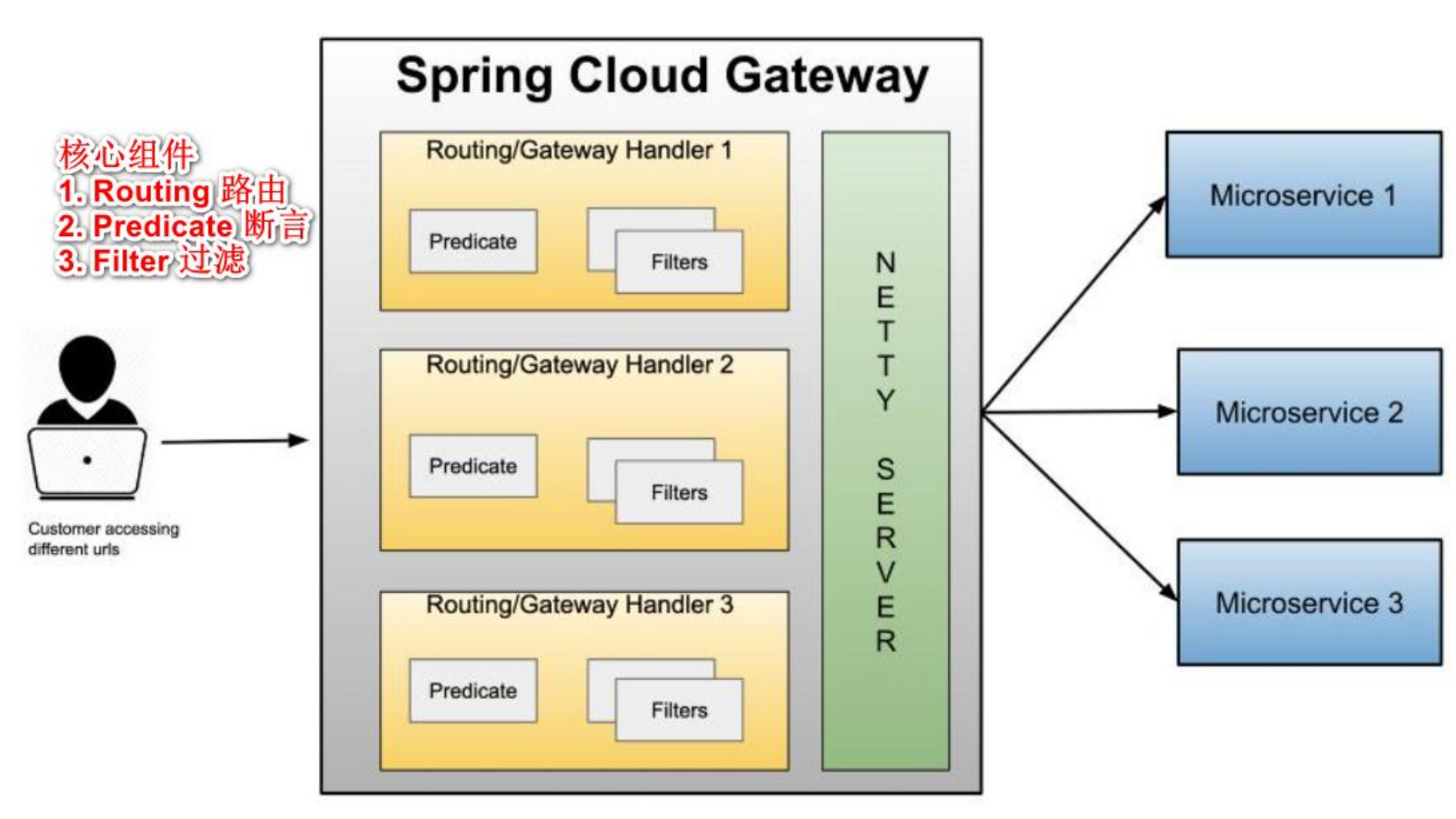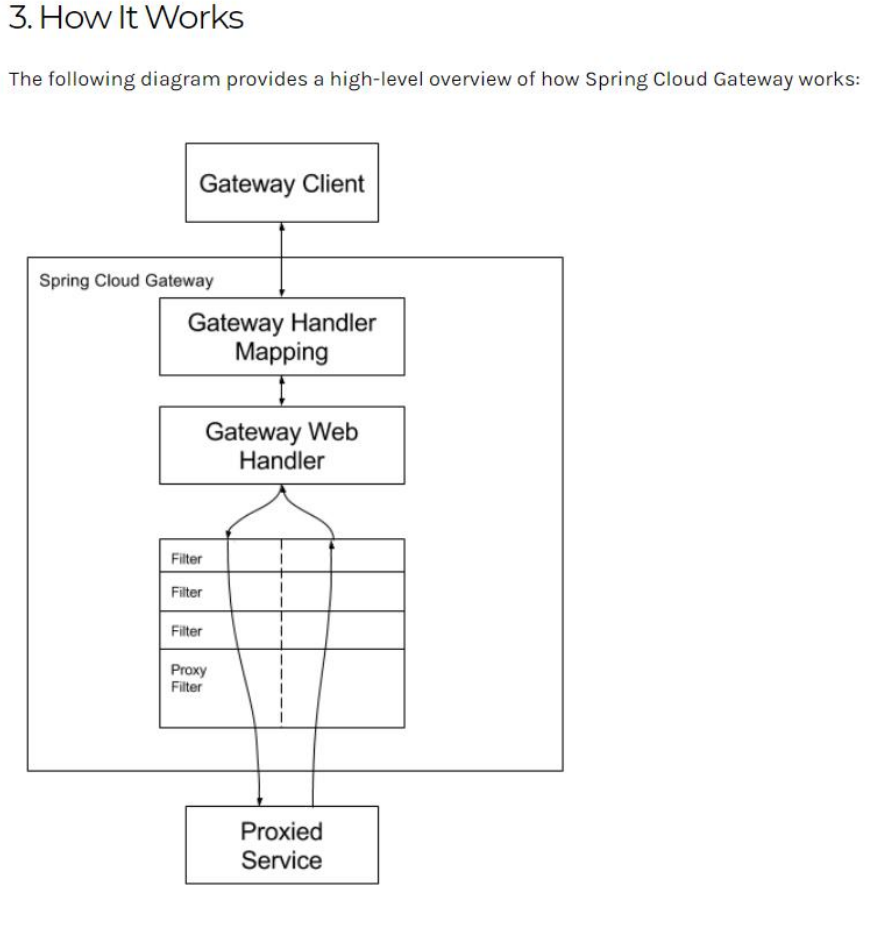Gateway源码解读
原创Gateway是什么?
- Gateway是在Spring生态系统上的API网关服务,基于Spring、SpringBoot和Project等技术
- Gateway旨在提供一种简单而有效的方式来对API进行路由,以及提供一些强大的过滤功能,如:熔断、限流、重试等
- Gateway官网链接:https://cloud.spring.io/spring-cloud-static/spring-cloud-gateway/2.2.1.RELEASE/reference/html/
- 核心功能:鉴权、流量控制、熔断、日志监控、反向代理
Gateway基本原理?

Gateway原理图
个人理解:
- web请求通过一些匹配条件,从而定位到真正的服务节点/微服务模块,但是在该转发过程的前后有一些精细化的控制
- predicate断言就是匹配条件
- filter过滤,个人感觉可以理解为网关的过滤机制,有了predicate断言和filter过滤,再加上目标url就可以实现一个具体的路由
- route路由:网关基本模块,由id,目标url,一系列断言和过滤器组成,如果断言为true那么就匹配该路由
- predicate断言:对http请求中的所有内容(如请求头or请求参数)进行匹配,如果请求与断言相匹配就路由
- filter过滤:可以再请求被路由的前后对请求进行处理
Gateway工作机制理解 How it works

How it works
流程理解:
- 客户端向Gateway发出请求,在Gateway Handler Mapping中找到了与请求相匹配的路由,将其转发到Gateway Web Handler
- Handler通过指定的过滤器链把请求发送到实际的服务业务逻辑,然后返回
- 过滤器之间用虚线是因为过滤器可以在请求之前pre或者请求之后post执行业务逻辑
- Filter在“pre”类型的过滤器可以做参数校验、权限校验、流量控制、日志输出、协议转换等
- Filter在“post”类型的过滤器可以做响应内容、响应头的修改、日志输出、流量监控等
- 综上所述:工作机制为 路由转发 + 执行过滤器链
前置知识:jdk8谓词
谓词是一个函数式接口,可以接受一个参数并返回一个布尔值,表示该参数是否满足某个条件
两个谓词接口:
接受一个参数的,java.util.function.Predicate<T>
@FunctionalInterface
public interface Predicate<T> {
/**
* Evaluates this predicate on the given argument.
*
* @param t the input argument
* @return {@code true} if the input argument matches the predicate,
* otherwise {@code false}
*/
boolean test(T t);
/**
* Returns a composed predicate that represents a short-circuiting logical
* AND of this predicate and another. When evaluating the composed
* predicate, if this predicate is {@code false}, then the {@code other}
* predicate is not evaluated.
*
* <p>Any exceptions thrown during evaluation of either predicate are relayed
* to the caller; if evaluation of this predicate throws an exception, the
* {@code other} predicate will not be evaluated.
*
* @param other a predicate that will be logically-ANDed with this
* predicate
* @return a composed predicate that represents the short-circuiting logical
* AND of this predicate and the {@code other} predicate
* @throws NullPointerException if other is null
*/
default Predicate<T> and(Predicate<? super T> other) {
Objects.requireNonNull(other);
return (t) -> test(t) && other.test(t);
}
/**
* Returns a predicate that represents the logical negation of this
* predicate.
*
* @return a predicate that represents the logical negation of this
* predicate
*/
default Predicate<T> negate() {
return (t) -> !test(t);
}
/**
* Returns a composed predicate that represents a short-circuiting logical
* OR of this predicate and another. When evaluating the composed
* predicate, if this predicate is {@code true}, then the {@code other}
* predicate is not evaluated.
*
* <p>Any exceptions thrown during evaluation of either predicate are relayed
* to the caller; if evaluation of this predicate throws an exception, the
* {@code other} predicate will not be evaluated.
*
* @param other a predicate that will be logically-ORed with this
* predicate
* @return a composed predicate that represents the short-circuiting logical
* OR of this predicate and the {@code other} predicate
* @throws NullPointerException if other is null
*/
default Predicate<T> or(Predicate<? super T> other) {
Objects.requireNonNull(other);
return (t) -> test(t) || other.test(t);
}
/**
* Returns a predicate that tests if two arguments are equal according
* to {@link Objects#equals(Object, Object)}.
*
* @param <T> the type of arguments to the predicate
* @param targetRef the object reference with which to compare for equality,
* which may be {@code null}
* @return a predicate that tests if two arguments are equal according
* to {@link Objects#equals(Object, Object)}
*/
static <T> Predicate<T> isEqual(Object targetRef) {
return (null == targetRef)
? Objects::isNull
: object -> targetRef.equals(object);
}
}接受两个参数的,java.util.function.BiPredicate<T,U>
@FunctionalInterface
public interface BiPredicate<T, U> {
/**
* Evaluates this predicate on the given arguments.
*
* @param t the first input argument
* @param u the second input argument
* @return {@code true} if the input arguments match the predicate,
* otherwise {@code false}
*/
boolean test(T t, U u);
/**
* Returns a composed predicate that represents a short-circuiting logical
* AND of this predicate and another. When evaluating the composed
* predicate, if this predicate is {@code false}, then the {@code other}
* predicate is not evaluated.
*
* <p>Any exceptions thrown during evaluation of either predicate are relayed
* to the caller; if evaluation of this predicate throws an exception, the
* {@code other} predicate will not be evaluated.
*
* @param other a predicate that will be logically-ANDed with this
* predicate
* @return a composed predicate that represents the short-circuiting logical
* AND of this predicate and the {@code other} predicate
* @throws NullPointerException if other is null
*/
default BiPredicate<T, U> and(BiPredicate<? super T, ? super U> other) {
Objects.requireNonNull(other);
return (T t, U u) -> test(t, u) && other.test(t, u);
}
/**
* Returns a predicate that represents the logical negation of this
* predicate.
*
* @return a predicate that represents the logical negation of this
* predicate
*/
default BiPredicate<T, U> negate() {
return (T t, U u) -> !test(t, u);
}
/**
* Returns a composed predicate that represents a short-circuiting logical
* OR of this predicate and another. When evaluating the composed
* predicate, if this predicate is {@code true}, then the {@code other}
* predicate is not evaluated.
*
* <p>Any exceptions thrown during evaluation of either predicate are relayed
* to the caller; if evaluation of this predicate throws an exception, the
* {@code other} predicate will not be evaluated.
*
* @param other a predicate that will be logically-ORed with this
* predicate
* @return a composed predicate that represents the short-circuiting logical
* OR of this predicate and the {@code other} predicate
* @throws NullPointerException if other is null
*/
default BiPredicate<T, U> or(BiPredicate<? super T, ? super U> other) {
Objects.requireNonNull(other);
return (T t, U u) -> test(t, u) || other.test(t, u);
}
}内置谓词工厂
如PathRoutePredicateFactory:根据请求的路径是否匹配给定的路径模式进行匹配
需求:将request作为参数传入谓词对象,取出request.getURI(),与Path中配置的regex判断
public class PathRoutePredicateFactory extends AbstractRoutePredicateFactory<PathRoutePredicateFactory.Config> {
private static final Log log = LogFactory.getLog(PathRoutePredicateFactory.class);
private static final String MATCH_TRAILING_SLASH = "matchTrailingSlash";
private PathPatternParser pathPatternParser = new PathPatternParser();
public Predicate<ServerWebExchange> apply(PathRoutePredicateFactory.Config config) {
final ArrayList<PathPattern> pathPatterns = new ArrayList();
synchronized(this.pathPatternParser) {
this.pathPatternParser.setMatchOptionalTrailingSeparator(config.isMatchTrailingSlash());
config.getPatterns().forEach((pattern) -> {
PathPattern pathPattern = this.pathPatternParser.parse(pattern);
pathPatterns.add(pathPattern);
});
}
return new GatewayPredicate() {
// 一个包装对象
public boolean test(ServerWebExchange exchange) {
// 取出该对象的uri
PathContainer path = PathContainer.parsePath(exchange.getRequest().getURI().getRawPath());
Optional<PathPattern> optionalPathPattern = pathPatterns.stream().filter((pattern) -> {
return pattern.matches(path);
}).findFirst();
if (optionalPathPattern.isPresent()) {
PathPattern pathPattern = (PathPattern)optionalPathPattern.get();
PathRoutePredicateFactory.traceMatch("Pattern", pathPattern.getPatternString(), path, true);
PathMatchInfo pathMatchInfo = pathPattern.matchAndExtract(path);
ServerWebExchangeUtils.putUriTemplateVariables(exchange, pathMatchInfo.getUriVariables());
return true;
} else {
PathRoutePredicateFactory.traceMatch("Pattern", config.getPatterns(), path, false);
return false;
}
}
public String toString() {
return String.format("Paths: %s, match trailing slash: %b", config.getPatterns(), config.isMatchTrailingSlash());
}
};
}
}这里同时也涉及到了工厂设计模式的一些概念
简单工厂模式:1个工厂产出n个产品,创建逻辑都写在一个方法里,无法根据不同的参数来创建产品
抽象工厂模式:1个工厂产出1个产品
当Gateway读取配置文件,读到断言的Path就知道去PathRoutePredicateFactory工厂产出该工厂的断言
工厂方法模式,工厂是一个抽象,产品是一个抽象,工厂实现与产品实现一一对应
Gateway源码
Gateway的自动配置:SpringBoot 在引入一个新的组件时,一般都会有对应的XxxAutoConfiguration类来对该组件进行配置,Gateway也不例外,在引入了以下配置后,就会生成对应的GatewayAutoConfiguration自动配置类,最核心是响应式的Web框
<dependency>
<groupId>org.springframework.cloud</groupId>
<artifactId>spring-cloud-starter-gateway</artifactId>
</dependency>GatewayAutoConfiguration自动配置类
@Configuration(proxyBeanMethods = false)
// spring.cloud.gateway.enabled配置项必须为true,自动配置才生效,默认为true
@ConditionalOnProperty(name = "spring.cloud.gateway.enabled", matchIfMissing = true)
@EnableConfigurationProperties
// 自动配置前置条件:引入了WebFlux 和 HttpHandler 组件
@AutoConfigureBefore({ HttpHandlerAutoConfiguration.class,
WebFluxAutoConfiguration.class })
// 自动配置后置组件:负载均衡组件
@AutoConfigureAfter({ GatewayLoadBalancerClientAutoConfiguration.class,
GatewayClassPathWarningAutoConfiguration.class })
@ConditionalOnClass(DispatcherHandler.class)
public class GatewayAutoConfiguration {
..... // 初始化各种bean
}GatewayClassPathWarningAutoConfiguration:Gateway基于Spring WebFlux实现,此配置类用于检查项目是否正确导入spring-boot-starter-webflux依赖,而不是错误导入spring-boot-starter-web依赖GatewayLoadBalancerClientAutoConfiguration:初始化LoadBalancerClientFilter
重点在GatewayAutoConfiguration这个配置类上:
- NettyConfiguration:使用HttpCliemt Bean,创建一个类型为org.springframework.cloud.NettyRoutingFilter的Bean对象,使用基于Netty实现的HttpClient请求后端http服务
- GlobalFilter:初始全局的GlobalFilter
- GateWayProperties:读取配置文件的RouteDefinition/FilterDefinition
- FilteringWebHandler:它的handle方法,形成过滤器链并顺序调用
@Override
public Mono<Void> handle(ServerWebExchange exchange) {
// 拿到对应的route
Route route = exchange.getRequiredAttribute(GATEWAY_ROUTE_ATTR);
// 取出此路由自定义的过滤器
List<GatewayFilter> gatewayFilters = route.getFilters();
List<GatewayFilter> combined = new ArrayList<>(this.globalFilters);
// 添加全局过滤器,合并所有的过滤器,形成过滤器链
combined.addAll(gatewayFilters);
// TODO: needed or cached?
// 排序
AnnotationAwareOrderComparator.sort(combined);
if (logger.isDebugEnabled()) {
logger.debug("Sorted gatewayFilterFactories: " + combined);
}
// 基于一个请求得到过滤器链
// 责任链模式
return new DefaultGatewayFilterChain(combined).filter(exchange);
}- PrefixPathGatewayFilterFactory:前面提及的工厂模式,很多个GatewayFilterFactory的创建
- RoutePredicateFactory:很多个RoutePredicateFactory的创建
- RoutePredicateHandlerMapping:getHandlerInternal() -> lookupRoute()很重要,可以看到前面提到的谓词调用,通过谓词调用来知道Route是谁了
/**
*
* @param webHandler 上边装配的FilteringWebHandler
* @param routeLocator 上边装配的CachingRouteLocator
*/
@Bean
public RoutePredicateHandlerMapping routePredicateHandlerMapping(
FilteringWebHandler webHandler, RouteLocator routeLocator,
GlobalCorsProperties globalCorsProperties, Environment environment) {
return new RoutePredicateHandlerMapping(webHandler, routeLocator,
globalCorsProperties, environment);
}
package org.springframework.cloud.gateway.handler;
import java.util.function.Function;
import reactor.core.publisher.Mono;
import org.springframework.cloud.gateway.config.GlobalCorsProperties;
import org.springframework.cloud.gateway.route.Route;
import org.springframework.cloud.gateway.route.RouteLocator;
import org.springframework.core.env.Environment;
import org.springframework.web.cors.CorsConfiguration;
import org.springframework.web.reactive.handler.AbstractHandlerMapping;
import org.springframework.web.server.ServerWebExchange;
import static org.springframework.cloud.gateway.handler.RoutePredicateHandlerMapping.ManagementPortType.DIFFERENT;
import static org.springframework.cloud.gateway.handler.RoutePredicateHandlerMapping.ManagementPortType.DISABLED;
import static org.springframework.cloud.gateway.handler.RoutePredicateHandlerMapping.ManagementPortType.SAME;
import static org.springframework.cloud.gateway.support.ServerWebExchangeUtils.GATEWAY_HANDLER_MAPPER_ATTR;
import static org.springframework.cloud.gateway.support.ServerWebExchangeUtils.GATEWAY_PREDICATE_ROUTE_ATTR;
import static org.springframework.cloud.gateway.support.ServerWebExchangeUtils.GATEWAY_ROUTE_ATTR;
/**
* @author Spencer Gibb
*/
public class RoutePredicateHandlerMapping extends AbstractHandlerMapping {
private final FilteringWebHandler webHandler;
private final RouteLocator routeLocator;
private final Integer managementPort;
private final ManagementPortType managementPortType;
public RoutePredicateHandlerMapping(FilteringWebHandler webHandler,
RouteLocator routeLocator, GlobalCorsProperties globalCorsProperties,
Environment environment) {
this.webHandler = webHandler;
this.routeLocator = routeLocator;
this.managementPort = getPortProperty(environment, "management.server.");
this.managementPortType = getManagementPortType(environment);
setOrder(1);
setCorsConfigurations(globalCorsProperties.getCorsConfigurations());
}
private ManagementPortType getManagementPortType(Environment environment) {
Integer serverPort = getPortProperty(environment, "server.");
if (this.managementPort != null && this.managementPort < 0) {
return DISABLED;
}
return ((this.managementPort == null
|| (serverPort == null && this.managementPort.equals(8080))
|| (this.managementPort != 0 && this.managementPort.equals(serverPort)))
? SAME : DIFFERENT);
}
private static Integer getPortProperty(Environment environment, String prefix) {
return environment.getProperty(prefix + "port", Integer.class);
}
@Override
protected Mono<?> getHandlerInternal(ServerWebExchange exchange) {
// don't handle requests on management port if set and different than server port
if (this.managementPortType == DIFFERENT && this.managementPort != null
&& exchange.getRequest().getURI().getPort() == this.managementPort) {
return Mono.empty();
}
exchange.getAttributes().put(GATEWAY_HANDLER_MAPPER_ATTR, getSimpleName());
// 查找路由
return lookupRoute(exchange)
// .log("route-predicate-handler-mapping", Level.FINER) //name this
.flatMap((Function<Route, Mono<?>>) r -> {
exchange.getAttributes().remove(GATEWAY_PREDICATE_ROUTE_ATTR);
if (logger.isDebugEnabled()) {
logger.debug(
"Mapping [" + getExchangeDesc(exchange) + "] to " + r);
}
exchange.getAttributes().put(GATEWAY_ROUTE_ATTR, r);
// 找到该路由对应的webHandler
return Mono.just(webHandler);
}).switchIfEmpty(Mono.empty().then(Mono.fromRunnable(() -> {
exchange.getAttributes().remove(GATEWAY_PREDICATE_ROUTE_ATTR);
if (logger.isTraceEnabled()) {
logger.trace("No RouteDefinition found for ["
+ getExchangeDesc(exchange) + "]");
}
})));
}
@Override
protected CorsConfiguration getCorsConfiguration(Object handler,
ServerWebExchange exchange) {
// TODO: support cors configuration via properties on a route see gh-229
// see RequestMappingHandlerMapping.initCorsConfiguration()
// also see
// https://github.com/spring-projects/spring-framework/blob/master/spring-web/src/test/java/org/springframework/web/cors/reactive/CorsWebFilterTests.java
return super.getCorsConfiguration(handler, exchange);
}
// TODO: get desc from factory?
private String getExchangeDesc(ServerWebExchange exchange) {
StringBuilder out = new StringBuilder();
out.append("Exchange: ");
out.append(exchange.getRequest().getMethod());
out.append(" ");
out.append(exchange.getRequest().getURI());
return out.toString();
}
protected Mono<Route> lookupRoute(ServerWebExchange exchange) {
return this.routeLocator.getRoutes()
// individually filter routes so that filterWhen error delaying is not a
// problem
// 循环取出每个route根据谓词进行判断
.concatMap(route -> Mono.just(route).filterWhen(r -> {
// add the current route we are testing
exchange.getAttributes().put(GATEWAY_PREDICATE_ROUTE_ATTR, r.getId());
// apply()其实就是谓词判断!!
// important!!!
return r.getPredicate().apply(exchange);
})
// instead of immediately stopping main flux due to error, log and
// swallow it
.doOnError(e -> logger.error(
"Error applying predicate for route: " + route.getId(),
e))
.onErrorResume(e -> Mono.empty()))
// .defaultIfEmpty() put a static Route not found
// or .switchIfEmpty()
// .switchIfEmpty(Mono.<Route>empty().log("noroute"))
.next()
// TODO: error handling
.map(route -> {
if (logger.isDebugEnabled()) {
logger.debug("Route matched: " + route.getId());
}
validateRoute(route, exchange);
return route;
});
/*
* TODO: trace logging if (logger.isTraceEnabled()) {
* logger.trace("RouteDefinition did not match: " + routeDefinition.getId()); }
*/
}
/**
* Validate the given handler against the current request.
* <p>
* The default implementation is empty. Can be overridden in subclasses, for example
* to enforce specific preconditions expressed in URL mappings.
* @param route the Route object to validate
* @param exchange current exchange
* @throws Exception if validation failed
*/
@SuppressWarnings("UnusedParameters")
protected void validateRoute(Route route, ServerWebExchange exchange) {
}
protected String getSimpleName() {
return "RoutePredicateHandlerMapping";
}
public enum ManagementPortType {
/**
* The management port has been disabled.
*/
DISABLED,
/**
* The management port is the same as the server port.
*/
SAME,
/**
* The management port and server port are different.
*/
DIFFERENT;
}
}组件关系图:

组件关系图
整个调用过程为:
GatewayAutoConfiguration中通过@ConditionalOnClass(DispatherHandler.class)确认加载了DispathcherHandler类,这个类是请求分发处理器,同时也是Spring WebFlux的访问入口,这个类和SPringMVC的兄弟DispatcherServlet功能相同(请求分发处理)。这个DispathcherHandler类的handle(ServerWebExchange exchange)根据请求最终获取WebHandler,也就说获得了FilterWebHander(上图2处),可以创建DefaultGatewayFilterChain并调用filter方法形成过滤链
@Override
public Mono<Void> handle(ServerWebExchange exchange) {
if (this.handlerMappings == null) {
return createNotFoundError();
}
if (CorsUtils.isPreFlightRequest(exchange.getRequest())) {
return handlePreFlight(exchange);
}
return Flux
// 1.遍历所有的 handlerMapping
.fromIterable(this.handlerMappings)
// 2.得到Mapping,根据Mapping查找到webHandler
.concatMap(mapping -> mapping.getHandler(exchange))
.next()
.switchIfEmpty(createNotFoundError())
// 3.调用对应的处理器
.flatMap(handler -> invokeHandler(exchange, handler))
// 4.返回处理结果
.flatMap(result -> handleResult(exchange, result));
}以上内容仅为本人学习所用,如有侵权请联系!
原创声明:本文系作者授权腾讯云开发者社区发表,未经许可,不得转载。
如有侵权,请联系 cloudcommunity@tencent.com 删除。
原创声明:本文系作者授权腾讯云开发者社区发表,未经许可,不得转载。
如有侵权,请联系 cloudcommunity@tencent.com 删除。
评论
登录后参与评论
推荐阅读
目录


